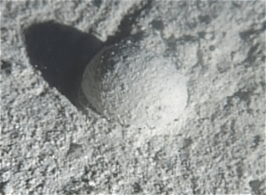Gromia sphaerica
Gromia sphaerica is a large spherical testate amoeba, a single-celled organism classed among the protists and is the largest in the genus Gromia. It was discovered in 2000, along the Oman margin of the Arabian sea, at depths from 1,163 to 1,194 meters (3,816 to 3,917 ft). Specimens range in size from 4.7 to 38 millimeters (0.19 to 1.50 inches) in diameter. The test (organic shell) is usually spherical in shape and honeycombed with pores. There are filaments on the bottom of the organism, where it is in contact with the seafloor, and it is mostly filled with stercomata (waste pellets).[1]
| Gromia sphaerica | |
|---|---|
| Scientific classification | |
| Domain: | Eukaryota |
| (unranked): | SAR |
| (unranked): | |
| Phylum: | |
| Class: | |
| Order: | |
| Family: | |
| Genus: | |
| Species: | G. sphaerica |
| Binomial name | |
| Gromia sphaerica Gooday, Bowser, Bett & Smith 2000 | |
In 2008, 30-millimeter (1.2-inch) specimens were found off the coast of Little San Salvador in the Bahamas by researchers from the University of Texas. These Gromia were discovered to make mud trails as much as 50 centimeters (20 inches) in length. It was previously thought that single-celled organisms were incapable of making these kinds of trails, and their cause was previously a source of speculation. The mud trails made by the Bahamian Gromia appear to match prehistoric mud trails from the Precambrian, including 1.8 billion year-old fossil trails in the Stirling formation in Australia.[2][3][4][5]
 Close-up of Gromia in place. Note the particles of sand and muck stuck to the surface.
Close-up of Gromia in place. Note the particles of sand and muck stuck to the surface. Multiple individuals of Gromia sphaerica on the slope of Exuma Valley, together with a shrimp for scale. The shrimp is about 10 cm long and maintains a horizontal position. Inset: details of individual traces.
Multiple individuals of Gromia sphaerica on the slope of Exuma Valley, together with a shrimp for scale. The shrimp is about 10 cm long and maintains a horizontal position. Inset: details of individual traces.
References
- Gooday, Andrew J; Bowser, Samuel S; Bett, Brian J; Smith, Craig R (January 2000). "A large testate protist, Gromia sphaerica sp. nov. (Order Filosea), from the bathyal Arabian Sea". Deep Sea Research Part II: Topical Studies in Oceanography. 47 (1–2): 55–73. doi:10.1016/S0967-0645(99)00100-9 – via Centre National de la Recherche Scientifique.
- Matz, Mikhail V.; Tamara M. Frank; N. Justin Marshall; Edith A. Widder; Sonke Johnsen (2008-12-09). "Giant Deep-Sea Protist Produces Bilaterian-like Traces" (PDF). Current Biology. Elsevier Ltd. 18 (18): 1–6. doi:10.1016/j.cub.2008.10.028. PMID 19026540. Retrieved 2008-12-05.
- Reilly, Michael (2008-11-20). "Single-celled giant upends early evolution". NBC News. Retrieved 2008-12-05.
- "Discovery of Giant Roaming Deep Sea Protist Provides New Perspective on Animal Evolution". University of Texas at Austin College of Natural Sciences. 2008-11-20. Retrieved 2019-07-21.
- "Rolling 'Sea Grape' Rocks The Fossil Record". ScienceDaily. 2008-12-04. Retrieved 2018-07-24.
External links